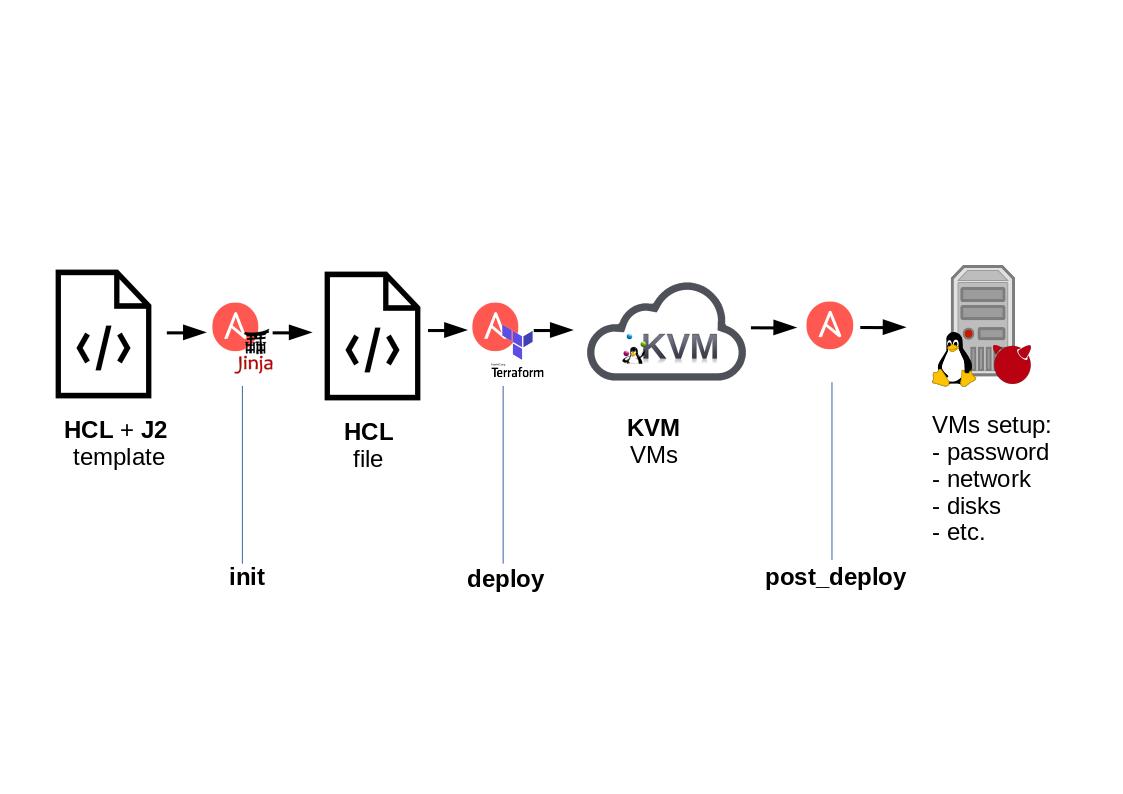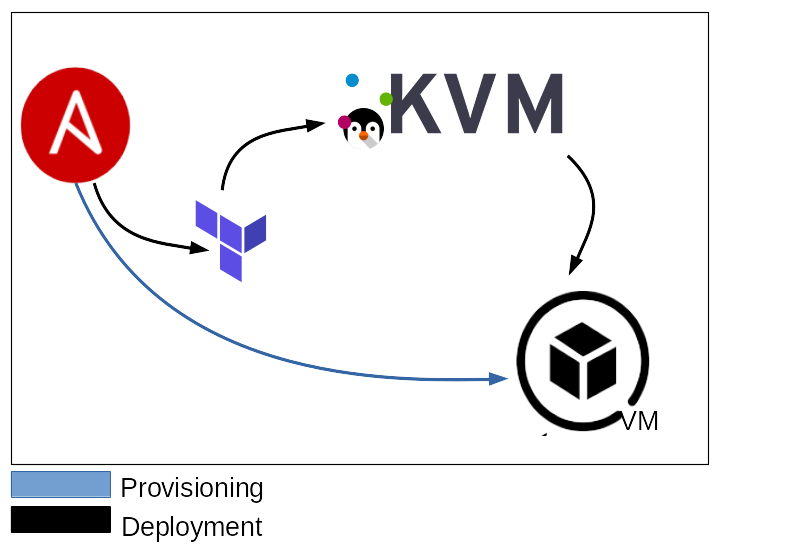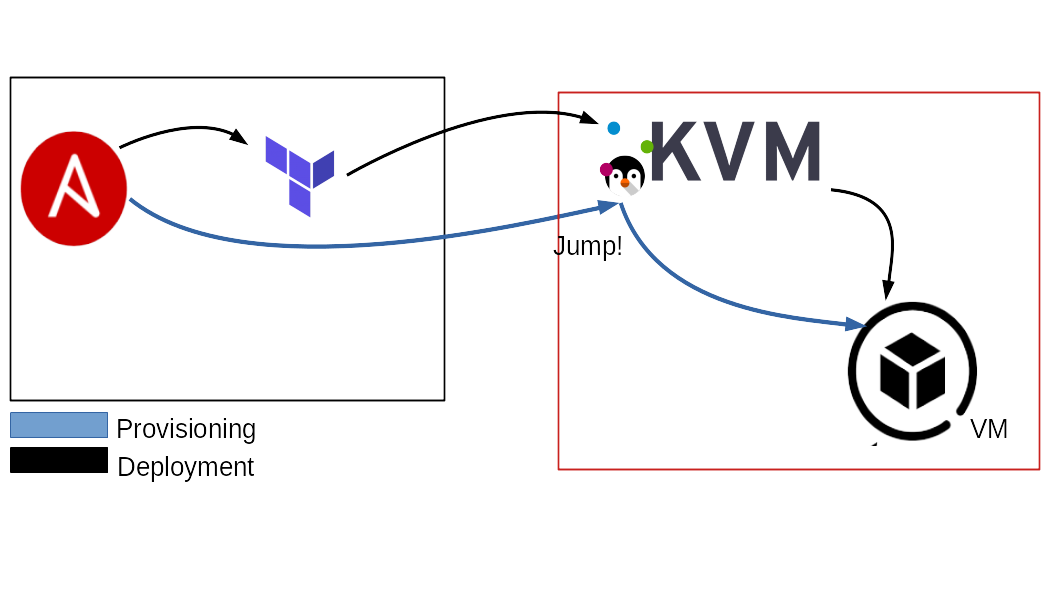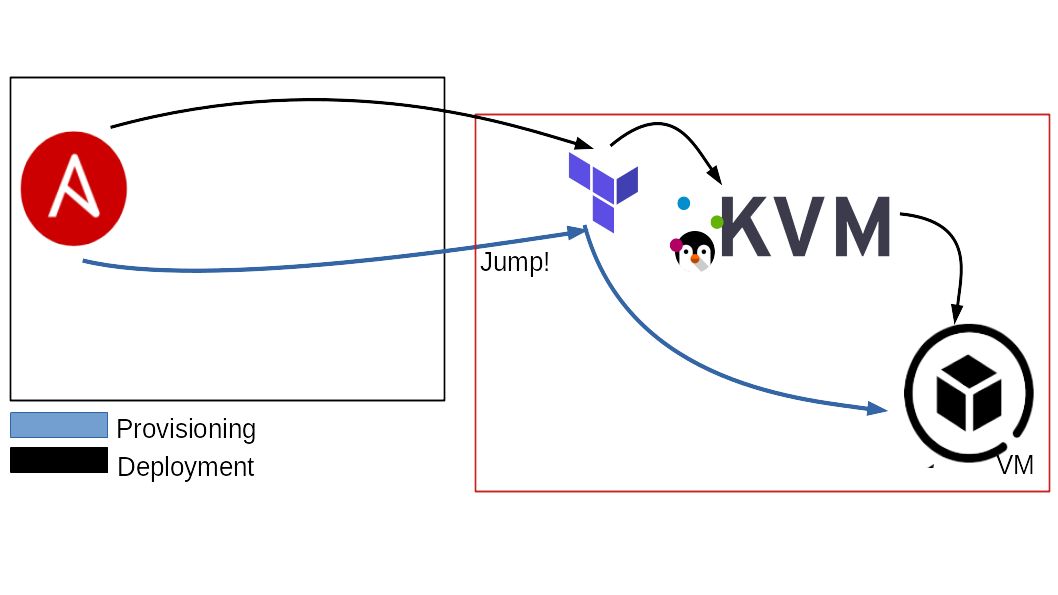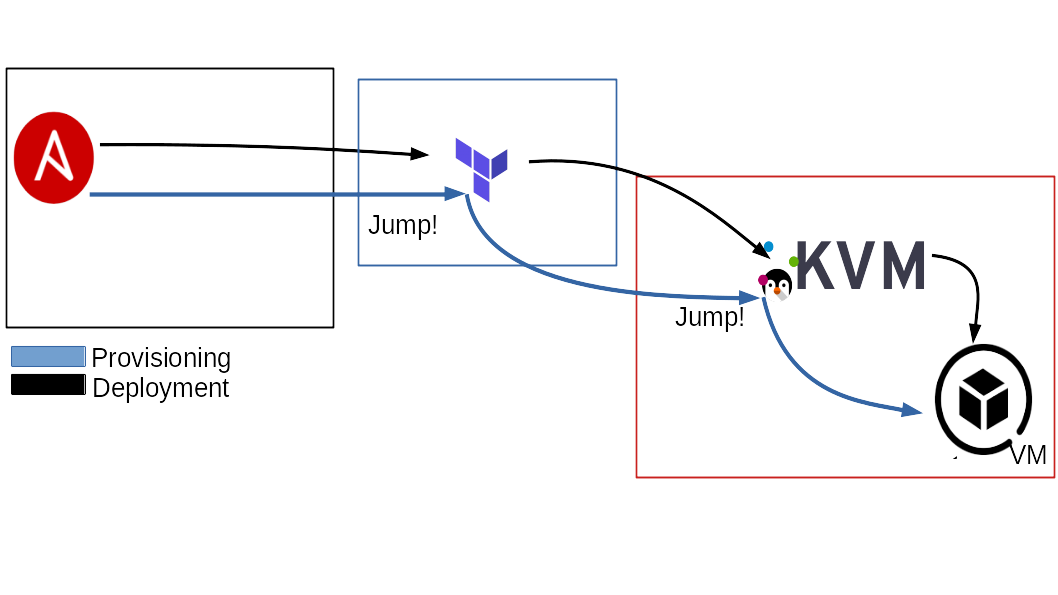89luca89 / Terrible
Labels
Projects that are alternatives of or similar to Terrible
Terrible: IaC for QEMU/KVM
Workflows Status
This Ansible playbook allows you to initialize and then deploy an entire infrastructure through the aid of Terraform, on a QEMU/KVM environment.
Terraform + Ansible
Table of Contents
Abstract
The Infrastructure as Code had considerable growth in the cloud in the last years. However, a separate discussion has to be done regarding the private cloud. For various reasons, companies may need to use an internal infrastructure instead of the cloud. Unfortunately, there aren't as many solutions for the private cloud as for the cloud. Our idea has been to implement a flexible and powerful solution to easily build an infrastructure from scratch. It uses the flexibility of Ansible and the power of Terraform allowing you to abstract both the creation and the provisioning of the infrastructure, describing the whole process in a single file.
Why not just use a single tool?
On our side, the decision has been driven by the need to create a single source of truth for both the creation and provisioning of the infrastructure. It has been possible by leveraging Ansible and Jinja2 flexibility to easily generate highly dynamical HCL files for Terraform and leverage its power and compatibility to build the infrastructure.
How It Works
The idea comes from the difficulty to automate the deployment of the VMs on a QEMU/KVM environment.
For this reason we decided to automate as much as possible the process of the deployment, using Ansible and Jinja2.
First of all we provided a basic HCL file (templated with Jinja2) to describe a basic VM implementation. This is what is usually called IaC.
Then using Terraform and its amazing provider for libvirt (https://github.com/dmacvicar/terraform-provider-libvirt), we deploy the resultants HCL files generated by Ansible.
The figure below describe the process in an easy way.
As you can see, we start having the templated file (terraform-vm.tf.j2).
When Ansible run, it generates n .tf files, depending on the VM specified into the inventory. This is the result of the initialization phase.
Once finished this task, the files are completed and ready to be used by Terraform.
At this time, Ansible takes these files and use Terraform for each instance of them. Once finished this task, the VMs, previously described into the inventory, are correctly deployed into the QEMU/KVM server(s).
Requirements
| Dependency | Minimum Version | Reference |
|---|---|---|
| Ansible | 2.9+ | https://docs.ansible.com/ |
| Terraform | 0.12+ | https://www.terraform.io/docs/index.html |
| Terraform Provider Libvirt | 0.6+ | https://github.com/dmacvicar/terraform-provider-libvirt/ |
| Libvirt (on the target) | 1.2.14+ | https://libvirt.org/docs.html |
Configuration
First of all you have to compose the inventory file in a right way. This means you have to describe the VMs you want to deploy into the server.
As you are going to check, there are some interesting variables you are allowed to use to properly describe your infrastructure.
Some of them are required and some others are optional.
Below you can check the basic structure for the inventory.
all:
vars:
...
hosts:
terraform_node:
...
hypervisor_1:
...
hypervisor_2:
...
children:
deploy:
vars:
pool_name: ...
...
children:
group_1:
hosts:
host_1:
...
vars:
...
group_2:
hosts:
host_2:
...
host_3:
...
group_3:
hosts:
host_4:
...
vars:
...
group_4:
hosts:
host_5:
...
Under the 1st vars tag, you can specify the various hypervisors you want to use to distribute your infrastructure.
Here's a little example:
all:
hosts:
terraform_node:
ansible_host: 127.0.0.1
ansible_connection: local
vars:
...
children:
deploy:
vars:
pool_name: defaul
...
In this example we specified the uri of the QEMU/KVM server (which is going to be common for all the VMs in this hypervisor group),
the storage pool name of the QEMU/KVM server and the terraform node address, which specify where Terraform is installed and where is going to be ran.
Now, for each VM we want to specify some property such as the number of the cpu(s), memory ram, mac_address, etc.
Here's a little example:
...
all:
hosts:
terraform_node:
ansible_host: 127.0.0.1
ansible_connection: local
hypervisor_1:
ansible_host: 127.0.0.1
ansible_connection: local
children:
deploy:
vars:
pool_name: default
disk_source: "~/VirtualMachines/centos8-terraform.qcow2"
children:
group_1:
hosts:
host_1:
os_family: RedHat
cpu: 4
memory: 8192
hypervisor: hypervisor_1
network_interfaces:
...
group_2:
hosts:
host_2:
os_family: RedHat
cpu: 2
hypervisor: hypervisor_1
host_3:
os_family: Suse
disk_source: "~/VirtualMachines/opensuse15.2-terraform.qcow2"
cpu: 4
memory: 4096
set_new_passowrd: password123
hypervisor: hypervisor_1
network_interfaces:
...
In this example, we specified 2 main groups (group_1, group_2) and linked the VMs to hypervisor_1.
These groups are composed overall by 3 VMs (host_1, host_2, host_3).
As you can see, not all the properties are specified for each machine. This is due to the default values of the variables provided by this playbook.
Thanks to the variabe hierarchy in Ansible, you can configure variables:
- Hypervisor wise
- VM groups wise
- Single VM wise
This will make easier to manage large homogeneous clusters, still retaining the power of per-VM customization.
In the example above, we can see, for hypervisor_1, the default OS for VMs is Centos, but we specified for host_3 to be an OpenSuse node. Similarly for the hypervisor_2, the default OS for VMs is Ubuntu, but we specified for the host_4 to be a Centos node.
This is valid for any variable in the playbook.
You can check the default values under default/main.yml.
Variables
Once you understand how to fill the inventory file, you are ready to check all the available variables to generate your infrastructure.
These variables are required:
-
ansible_host:
required. Specify the ip address for the VM. If not specified, a random ip is assigned. -
ansible_jump_hosts:
requiredif terraform_bastion_enabled isTrue. Specify one or more jumphost/bastions for the ansible provisioning part. -
cloud_init:
optional. Specify if the VM uses a cloud-init image or not.FalseIf not specified. -
disk_source:
required. Specify the (local) path to the virtual disk you want to use to deploy the VMs. -
data_disks:
optional. Specify additional disks to be added to the VM. Check disks section for internal required varibles: HERE -
network_interfaces:
required. Specify VM's network interfaces, check network section for internal required variables: HERE -
os_family:
required. Specify the OS family for the installation. Possible values are:RedHat,Debian,Suse,Alpine,FreeBSD. -
pool_name:
required. Specify the storage pool name where you want to deploy the VMs on the QEMU/KVM server. -
ssh_password:
required. Specify the password to access the deployed VMs. -
ssh_port:
required. Specify the port to access the deployed VMs. -
ssh_user:
required. Specify the user to access the deployed VMs. -
ssh_public_key_file:
required. Specify the ssh public key file to deploy on the VMs. -
hypervisor:
required. Specify on which hypervisor to deploy the Infrastructure.
Ansible hosts required outside the deploy group:
-
terraform_node:
required. Specify the the machine that performs the Terraform tasks. -
hypvervisor_[0-9+]:
required. Specify at least one machine that is the QEMU/KVM hypervisor. The default value of 127.0.0.1 indicates that the machine that perform the Terraform tasks is the same that runs the Ansible playbook. In case the Terraform machine is not the local machine, you can specify the ip/hostname of the Terraform node. More details could be found here: HERE
These variable are optional, there are sensible defaults set up, most of them can be declared from hypervisor scope to vm-group scope and per-vm scope:
-
change_passwd_command:
optional. Specify a different command to be used to change the password to the user. If not specified the default command is used. Default:echo root:{{ set_new_password }} | chpasswd. This variable become really useful when you are using a FreeBSD OS. -
cpu:
optional. Specify the cpu number for the VM. If not specified, the default value is taken. Default:1 -
memory:
optional. Specify the memory ram for the VM. If not specified, the default value is taken. Default:1024 -
set_new_password:
optional. Specify a new password to access the Vm. If not specified, the default value (ssh_password) is taken. -
vm_autoboot:
optional. Specify if the VM should be automatically started at boot. Default:False
Terraform Node, Bastions & Jumphosts
The following section will describe some different scenarios that may appear during a typical deployment day.
As described above, the terraform_node variable is required.
The terraform_node could be local or remote.
A really common scenario will have a local Terraform node. This could be declared as follow:
all:
vars:
...
hosts:
terraform_node:
ansible_host: 127.0.0.1
ansible_connection: local
hypervisor_1:
ansible_host: 127.0.0.1
ansible_connection: local
This scenario assumes that the terraform_node is the same host that is running the Ansible playbook.
This case will ask Terraform to connect to QEMU/KVM using the uri qemu:///system.
If you want to use a remote QEMU/KVM server instead, you can do this as follow:
all:
vars:
...
hosts:
terraform_node:
ansible_host: 127.0.0.1
ansible_connection: local
hypervisor_1:
ansible_host: remote_kvm_machine.domain
ansible_user: root
ansible_port: 22
ansible_ssh_pass: password
This case will ask Terraform to connect to the QEMU/KVM server using the following uri: qemu+ssh://[email protected]_kvm_machine.domain/system.
This also setup the Terraform internal ssh connection to use it as a bastion host to connect to his VMs.
Also, Terraform could be separated from Ansible, and be located on a remote server.
You can declare it simply by using the ansible_host variable, as follow:
all:
vars:
...
hosts:
terraform_node:
ansible_host: remote_terraform_node.domain
ansible_connection: ssh # or paramiko or whatever NOT local
hypervisor_1:
ansible_host: remote_terraform_node.domain
ansible_connection: ssh # or paramiko or whatever NOT local
ansible_user: root
ansible_port: 22
ansible_ssh_pass: password
This assumes that the terraform_node is the same host that is running the QEMU/KVM hypervisor.
This case will ask Terraform to connect to QEMU/KVM using the uri qemu:///system.
The post-deployment task of this Ansible playbook, has to use a jumphost to get access to the VMs of the internal network. For this reason we need to use the terraform_node as jumphost to reach them.
Also, if you have a remote QEMU/KVM server and a remote Terraform server, you can use them as follow:
all:
vars:
...
hosts:
terraform_node:
ansible_host: remote_terraform_node.test.com
ansible_connection: ssh # or paramiko or whatever NOT local
hypervisor_1:
ansible_host: remote_kvm_machine.domain
ansible_user: root
ansible_port: 22
ansible_ssh_pass: password
This case will ask Terraform to connect to QEMU/KVM using the uri: qemu+ssh://[email protected]_kvm_machine.domain/system.
This also setup the Terraform internal ssh connection to use it as a bastion to connect to its VMs.
Being already remote, this will set up 2 jumphost(s) for Ansible, one is the terraform_node, the other
one is the ansible_host.
Network
Network declaration is mandatory and per-vm.
Declare each device you want to add inside the network_interfaces dictionary.
Be aware that:
- the order of declaration is important
- the NAT device should always be present (unless you can control your DHCP leases for the external devices) and that should be the first device. It is important because it's the way the playbook has to communicate with the VM before setting up all the userspace networks.
- the
default_routeshould be assigned to one interface to function properly. If not set it's equal to False.
Supported interface types:
natmacvtapbridge
Structure:
all:
vars:
pool_name: default
disk_source: "~/VirtualMachines/centos8-terraform.qcow2"
hosts:
terraform_node:
ansible_host: 127.0.0.1
ansible_connection: local
hypervisor_1:
ansible_host: 127.0.0.1
ansible_connection: local
children:
group_1:
hosts:
host_1:
ansible_host: 172.16.0.155
os_family: RedHat
cpu: 4
memory: 8192
hypervisor: hypervisor_1
network_interfaces:
# Nat interface, it should always be the first one you declare.
# it does not necessary have to be your default_route or main ansible_host,
# but it's important to declare it so ansible has a way to communicate with
# the VM and setup all the remaining networks.
iface_1:
name: nat # mandatory
type: nat # mandatory
ip: 192.168.122.47 # mandatory
gw: 192.168.122.1 # mandatory
dns: # mandatory
- 1.1.1.1
- 8.8.8.8
mac_address: "AA:BB:CC:11:24:68" # optional
# default_route: False
iface_2:
name: ens1p0 # mandatory
type: macvtap # mandatory
ip: 172.16.0.155 # mandatory
gw: 172.16.0.1 # mandatory
dns: # optional
- 1.1.1.1
- 8.8.8.8
default_route: True # at least one true mandatory, false is optional.
Variables explanation:
-
name:
requiredSpecify the name for the connection, this is important forbridgeandmacvtaptypes as it will be the interface/bridge on the host on which they will be created. -
type:
requiredSpecify the type of the interface, supported types are nat, macvtap, bridge. -
ip:
requiredSpecify the IP to assign to this interface. -
gw:
requiredSpecify the Gateway of this interface. -
default_route:
at least one requiredSpecify if this interface is the default route or not. At least one interface at True. -
dns:
requiredSpecify the dns list for this interface, this is an array of IPs. -
mac_address:
optionalSpecify the mac address for this interface.
The playbook will use the available IP returned from the terraform apply command to access the machines
and use the os_family way to setup the user-space part of the network:
- static IPs
- routes
- gateways
- DNS
After this, the playbook will set the ansible_host variable to its original value, and proceed with
the provisioning.
This is important because it will make ansible_host independent from the internal management interface
needed for this network bootstrap tasks, making it easily compatible with any type of role that you
want to perform after this.
During this process, virtual networks (bridges, VLANs, etc...) inside the vm will be ignored, this will improve detection of the networks we want to manage, improving compatibility with docker, k8s, nested-virtualization, etc...
Storage
This section explain how you can add some additional disk to the VMs.
Suppose you want to create a VM that needs a large amount of storage space, and a separated disk just to store the configurations. Doing this is quite simple.
The main variable you need is data_disks. The you have to specify the disks and the related properties for each of them.
If data_disks is mentioned in your inventory, the following variables are required:
-
size:
required. Specify the disk size expressed in GB. (es.size: 1means 1GB) -
pool:
required. Specify the pool where you want to store the additional disks. -
format:
require. Specify the filesystem format you want to apply to the disk. Available filesystems are specified below. -
mount_point:
required. Specify the mount point you want to create for the disk, usenoneif declaring a swap disk. -
encryption:
required. Specify the mount point of the disk. Available values could beTrueorFalse.
N.B. Each disk declared needs to have a unique name (ex. you can't have the name disk0 declared twice).
| OS Family | Supported Disk Format | Encryption Supported |
|---|---|---|
| Debian |
ext2, ext3, ext4, swap
|
yes |
| Alpine |
ext2, ext3, ext4, swap
|
yes |
| FreeBSD |
ufs, swap
|
no |
| RedHat |
ext2, ext3, ext4, xfs, swap
|
yes |
| Suse |
ext2, ext3, ext4, xfs, swap
|
yes |
Let's take a look at how the inventory file is going to be fill.
all:
vars:
provider_uri: "qemu:///system"
pool_name: default
disk_source: "~/VirtualMachines/centos8-terraform.qcow2"
hosts:
terraform_node:
ansible_host: 127.0.0.1
ansible_connection: local
hypervisor_1:
ansible_host: 127.0.0.1
ansible_connection: local
children:
group_1:
hosts:
host_1:
ansible_host: 172.16.0.155
os_family: RedHat
cpu: 4
memory: 8192
hypervisor: hypervisor_1
# Here we start to declare
# the additional disk.
data_disks:
# Here we declare the disk name
disk-storage: # Uniqe name to identify the disk unit.
size: 100 # Disk size = 100 GB
pool: default # Store the disk image into the pool = default.
format: xfs # Disk Filesystem = xfs
mount_point: /mnt/data_storage # The path where the disk is mounted, none is using swap
encryption: True # Enable disk encryption
# Here we declare the disk name
disk-swap: # Uniqe name to identify the disk unit.
size: 1 # Disk size = 1 GB
pool: default # Store the disk image into the pool = default.
format: swap # Disk Filesystem = swap
mount_point: none # The path where the disk is mounted, none if using swap
encryption: False # Does not enable disk encryption
Compatibility
Actually the playbook is supporting the most common 4 OS families for the Guests:
- RedHat (including Centos, Fedora and derivates)
- Debian (Including Ubuntu and derivates)
- Alpine
- Suse (Thumbleweed and Leap)
- FreeBSD
This means you are able to generate the infrastructure using the OS listed above.
Hypervisor OS is agnostic, as long as requirements are met.
Installation
Before using Terrible, the following system dependencies needs to be installed: dependencies.
Use the following command to satisfy the project dependencies:
pip3 install --user -r requirements.txt
Container Image
To avoid boring dependencies installation to make Terrible works and speed up your infrastructure deployment, we provided a Dockerfile to build by yourself a minimal image with all you need inside.
We use a debian:buster-slim image to have a compact system, combined with a full compatibility with required tools. The container image uses the latest Terrible tag's release.
The minimum packages required to run the container image is Docker (or Podman) and QEMU/KVM installed on the system.
Pull
If you are a lazy person (just like us), you can directly pull the latest image release from DockerHub.
docker pull 89luca89/terrible:latest
Build
To build the image, instead, type the following command:
docker build -t terrible .
This will take some minutes.
Run
Once you built the image, you are ready to run it as in the example below:
docker run \
-it \
--rm \
-v /var/run/libvirt/libvirt-sock:/var/run/libvirt/libvirt-sock \
-v ./inventory-test.yml:/root/terrible-1.1.1/inventory-test.yml \
-v ~/VirtualMachines/:/opt/ \
-v ~/.ssh/:/root/.ssh/ \
89luca89/terrible
N.B. If you are using RHEL, CentOS or Fedora you need to add the --privileged flag because otherwise SELinux does not allow it to access the libvirt socket.
N.B. If you are using your local QEMU/KVM instance, remember to add --net=host to the command.
Notes:
-
The volume
/var/run/libvirt/libvirt-sockis mandatory if you want to run Terrible locally (a local QEMU/KVM instance). In this way you directly interact with the QEMU/KVM api, provided by the system. -
The volume
./inventory-test.ymlis to include the inventory inside the container, to deploy the infrastructure. -
The volume
~/VirtualMachines/is to include theqcow2images inside the container to deploy them. -
The volume
~/.sshis to include your ssh keys into the container and deploy them inside the infrastructure machines.
Usage
To speed up your deployment process, we have made available our Packer template files.
The other repository could be found here: packer-terraform-kvm.
Once composed the inventory file, it's time to run your playbook.
To pull up infrastructure:
ansible-playbook -i inventory.yml -u root main.yml
To validate the inventory file:
ansible-playbook -i inventory.yml -u root main.yml --tags validate
To pull down infrastructure (maintaining the resources in place):
ansible-playbook -i inventory.yml -u root main.yml --tags destroy
To completely delete the infrastructure:
ansible-playbook -i inventory.yml -u root main.yml --tags purge
Outputs
Based on your inventory, the complete state of the infrastructure (TF files, TF states, LUKS keys etc...)
will be recorded to ${INVENTORY_NAME}-state.tar.gz this file is important to track the
state of an infrastructure.
You can (and should) save this state file to keep track of the infrastructure complete state, the *.tar.gz will be restored and saved on each run.
Authors
- Luca Di Maio [email protected]
- Alessio Greggi [email protected]
License
- GNU GPLv3, See LICENSE file.








